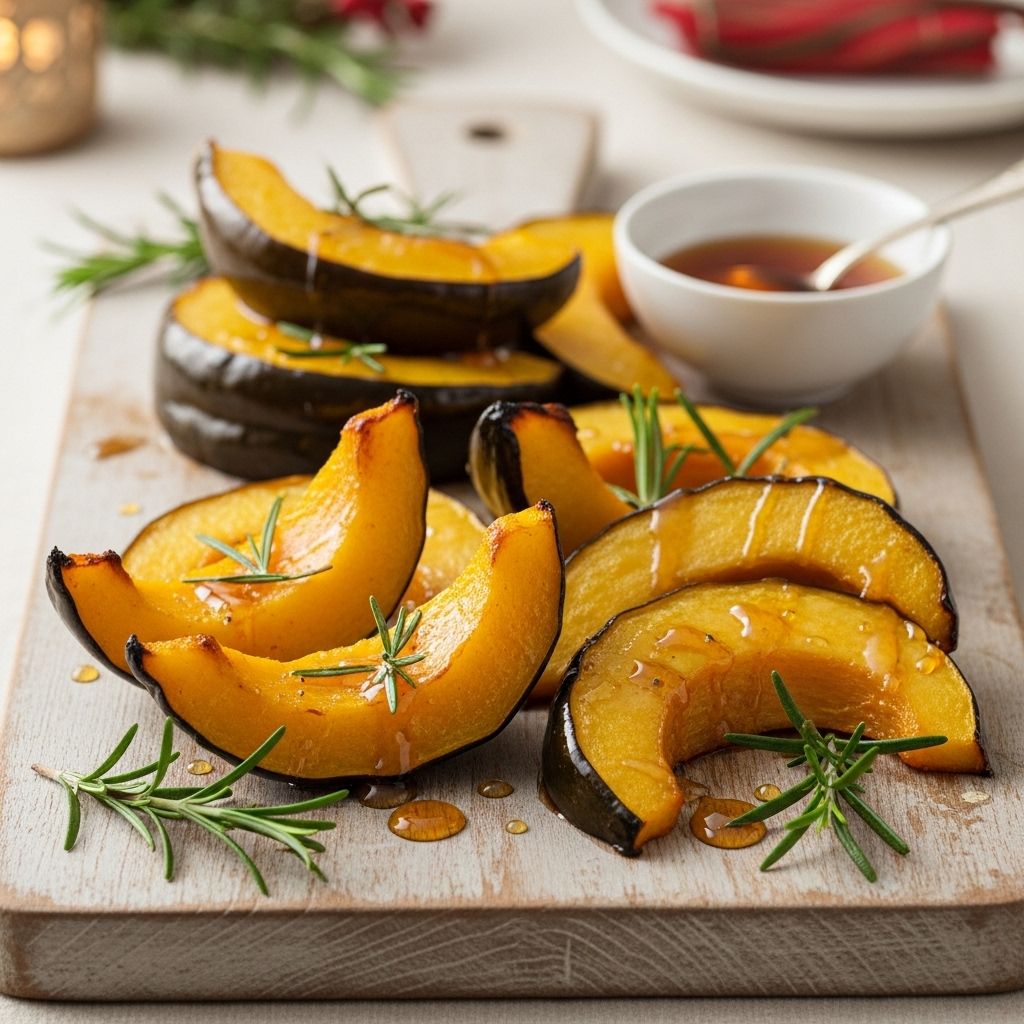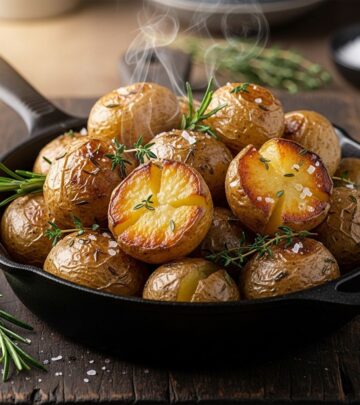Sweet-Roasted Rosemary Acorn Squash Wedges Recipe
A buttery-sugar glaze elevates cozy autumn dinners with irresistibly tender goodness.

Autumn brings with it a symphony of flavors, and few ingredients capture the essence of the season quite like acorn squash. These Sweet-Roasted Rosemary Acorn Squash Wedges represent the perfect marriage of natural sweetness and aromatic herbs, creating a side dish that’s both elegant and comforting. This recipe embraces the philosophy that holidays are for celebration, not restraint, delivering a decadent dish that will have your guests asking for seconds.
The Magic of Acorn Squash
Acorn squash stands as one of winter’s most versatile vegetables, with its distinctive ridged exterior and sweet, nutty flesh. Unlike its cousin the butternut squash, acorn squash offers a more compact size that’s perfect for individual servings or family-style presentations. The natural sweetness of this gourd pairs beautifully with both savory and sweet preparations, making it an ideal canvas for bold flavors like fresh rosemary and rich brown sugar.
When selecting acorn squash for this recipe, look for specimens that feel heavy for their size with unblemished, dark green skin. The stem should be dry and firmly attached, indicating proper ripeness. A good acorn squash will have a golden patch where it rested on the ground during growing, signaling it’s reached peak maturity.
Essential Ingredients for Success
The beauty of this recipe lies in its simplicity, requiring just a handful of quality ingredients that work together to create something extraordinary. The foundation begins with two medium acorn squashes, which will yield approximately eight generous wedges perfect for serving a family gathering.
Softened butter forms the base of our flavor paste, providing richness and helping the seasonings adhere to the squash. The butter should be soft enough to mix easily but still maintain some structure – removing it from refrigeration about an hour before cooking achieves the perfect consistency.
Brown sugar adds the sweet component that caramelizes beautifully during roasting, creating those irresistible golden edges. Pack the brown sugar lightly when measuring to ensure the right balance of sweetness without overwhelming the squash’s natural flavor.
Fresh rosemary provides the aromatic element that elevates this dish from simple to spectacular. The woody herb’s pine-like fragrance complements the earthy squash perfectly, while its robust flavor holds up beautifully to the long roasting process.
Preparation Techniques
The key to perfectly roasted acorn squash wedges begins with proper preparation. Start by preheating your oven to 350°F (175°C), which provides the ideal temperature for slow, even cooking that develops the squash’s natural sugars.
Cutting acorn squash requires a sharp, heavy knife due to the tough exterior. Begin by cutting each squash in half from top to bottom, creating two equal halves. Don’t worry if the cuts aren’t perfectly straight – rustic presentation adds to the dish’s charm. Use a sturdy spoon to scrape out all the seeds and stringy pulp from the center cavity, creating clean wells that will hold our flavor mixture.
Next, cut each half into four equal wedges, maintaining the skin for structural support and presentation. The skin becomes tender during roasting and adds visual appeal to the finished dish.
The Roasting Process
Place the wedges skin-side down in a large baking dish, arranging them so they don’t overlap. This positioning allows the cut surface to caramelize while the skin protects the base. Drizzle lightly with olive oil and sprinkle with a pinch of salt to enhance the natural flavors.
The initial 15-20 minute roast begins the cooking process, softening the squash slightly and preparing it to absorb the rich butter mixture. This pre-roasting step ensures even cooking throughout.
While the squash begins its transformation in the oven, prepare the flavor paste by combining softened butter with packed brown sugar, finely minced fresh rosemary, and a dash of salt. The mixture should have a paste-like consistency that spreads easily but holds its shape.
Creating the Perfect Glaze
After the initial roasting period, remove the squash from the oven and generously spread the butter-sugar-rosemary mixture over each wedge. Don’t hold back – this is where the magic happens. The mixture will melt and bubble during the remaining cooking time, creating a glossy glaze that penetrates the squash flesh.
Return the dish to the oven for an additional 20-30 minutes, basting the wedges with the melted mixture halfway through cooking. This basting step ensures even coverage and prevents the tops from becoming too dark while the squash finishes cooking.
Achieving Perfect Doneness
The squash is ready when it’s fork-tender and beautifully caramelized on top. The edges should be golden brown, and the flesh should yield easily to gentle pressure. The natural sugars in both the squash and brown sugar will have created a glossy, amber coating that’s simply irresistible.
The cooking liquid at the bottom of the dish becomes a precious sauce that shouldn’t be wasted. This concentrated mixture of butter, brown sugar, rosemary, and squash juices creates the perfect finishing touch for the dish.
Serving Suggestions and Variations
These wedges shine as part of a traditional holiday menu, pairing beautifully with roasted turkey, ham, or pork. The sweet and savory profile complements rich proteins while providing a colorful, festive addition to the dinner table.
For an interesting variation, consider adding red onion wedges to the baking dish alongside the squash. The onions will caramelize alongside the squash, adding another layer of flavor complexity.
Serve the wedges directly from the baking dish to maintain their temperature and rustic charm. Just before serving, drizzle the concentrated cooking liquid over the wedges one final time for maximum impact.
Storage and Reheating Tips
Leftover wedges can be stored in the refrigerator for up to three days. To reheat, place them in a 325°F oven until warmed through, which helps maintain their texture better than microwave reheating. The butter mixture may separate slightly when cold, but gentle reheating will restore its glossy appearance.
Nutritional Benefits
Despite its indulgent preparation, acorn squash provides significant nutritional value. It’s rich in vitamin A, vitamin C, potassium, and fiber. The antioxidants in acorn squash support immune function, while the fiber aids digestion. Even with the added butter and sugar, this dish provides more nutrients than many traditional holiday sides.
Frequently Asked Questions
Can I prepare this dish ahead of time?
Yes, you can cut the squash and prepare the butter mixture up to a day in advance. Store cut squash covered in the refrigerator and bring to room temperature before roasting. The butter mixture can be made ahead and stored covered at room temperature.
What other squash varieties work with this recipe?
Butternut squash, delicata squash, or even sweet potatoes can be substituted using the same technique. Adjust cooking times based on the size and density of your chosen vegetable.
Can I reduce the butter and sugar for a lighter version?
While you can reduce both ingredients by half, the resulting dish will be less caramelized and rich. Consider using maple syrup as a natural sweetener alternative, reducing the quantity to about 3 tablespoons.
How do I know when the squash is properly cooked?
Properly cooked acorn squash should be tender when pierced with a fork, with golden-brown caramelized edges. The flesh should be creamy and easily scooped from the skin.
Can I use dried rosemary instead of fresh?
Fresh rosemary is strongly recommended for the best flavor, but if using dried, reduce the quantity to 1 tablespoon and add it to the butter mixture with a small amount of olive oil to help rehydrate the herbs.
This Sweet-Roasted Rosemary Acorn Squash Wedges recipe embodies the spirit of autumn entertaining – rich, flavorful, and utterly satisfying. While it may not be the lightest side dish on your table, it will certainly be the most memorable, creating those perfect holiday moments that guests will talk about long after the meal ends.
References
- https://ediblesarasota.ediblecommunities.com/recipe/recipes-spiced-roasted-acorn-squash-wedges-fresh-rosemary/
- https://www.keyingredient.com/recipes/70761272/pioneer-womans-sweet-roasted-rosemary-acorn-squash/
- https://aprettylifeinthesuburbs.com/roasted-brown-sugar-rosemary-squash/
- https://www.thepioneerwoman.com/food-cooking/recipes/a8895/sweet-roasted-rosemary-acorn-squash-wedges/
- https://www.leppfarmmarket.com/sweet-roasted-rosemary-acorn-squash-wedges/
- https://tastykitchen.com/recipes/sidedishes/sweet-roasted-rosemary-acorn-squash-wedges/
Read full bio of medha deb












